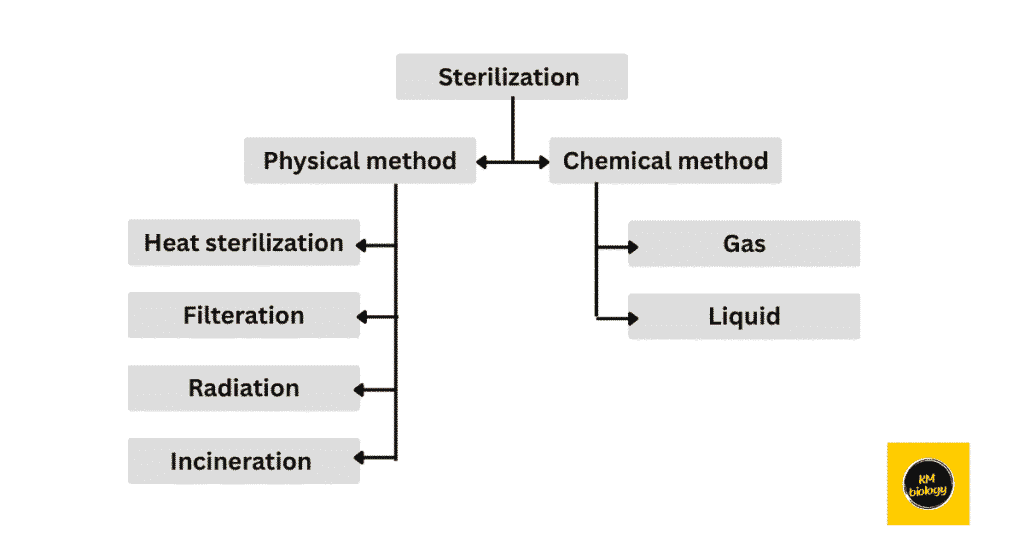Sterilization is an important process in the laboratory process. In previously we have seen the different type of growth medium used for cultivation of microbes. Once we have the desired medium in mind for cultivation of bacteria. we need a contamination free environment and the lab ware for preparation of media.
What is Sterilization?
Sterilization is the complete removal or destruction of all forms of microbial life, including:
- Bacteria
- Viruses
- Fungi
- Spores (which are highly resistant forms)
It is a critical process in microbiology, medicine, pharmaceuticals, food safety, and research labs to prevent contamination and infection.
Why is Sterilization Important?
- To ensure safety in medical and surgical procedures
- To prevent contamination in microbiological experiments
- To keep lab equipment and culture media free of unwanted microbes
- To preserve food and pharmaceutical products
- To control the spread of disease-causing microorganisms
Difference Between Sterilization and Disinfection
Sterilization means Destroys all forms of life, including spores and Disinfection Kills most microbes, but not always spores
Types of Sterilization Methods
Sterilization methods are broadly classified into physical and chemical methods.

Physical Methods of Sterilization
The physical method of sterilization involves using physical agents—such as heat, radiation, or filtration—to kill or remove all forms of microbial life, including bacteria, viruses, fungi, and spores. These methods are commonly used in laboratories, healthcare settings, and food industries to ensure sterility.
Heat Sterilization
Heat is the most commonly used and reliable method. There is two way to use the heat for the sterilization. One is moist heat and is more effective and the second dry heat because it penetrates better and works faster.
Dry heat method –
- This method uses hot air (e.g., 160–180°C for 2 hours). It work by oxidizing cellular components.
- Used for glassware, metal instruments, oils, and powders.
- Instrument used for the dry heat – Hot Air oven.
Moist heat method –
- This method uses steam under pressure (typically 121°C at 15 psi for 15–20 minutes) to kill microorganisms by denaturing proteins. It is effective against spores.
- It is commonly used for surgical instruments, culture media, and for dry heat sensitive material like plastics etc.
- Autoclave is one of the instrument used for moist heat treatment for the sterilization.
Filtration
This is mechanical removal of microbes using filters with pore sizes typically 0.22 µm. This method is used for heat-sensitive liquids and gases (e.g., antibiotics, enzyme solutions).
- Removes microbes from liquids or air without using heat.
- Useful for heat-sensitive materials like antibiotics, vitamins, or vaccines.
- Types of filters:
- Membrane filters for the filtration of media etc.
HEPA filters (for air) (in the laminar air flow) for the clean environment preparation for microbial work.
Radiation
Radiation sterilization is a physical method of sterilization that uses electromagnetic radiation to kill or inactivate microorganisms (such as bacteria, viruses, and spores). It works by damaging the DNA and other cellular components of the microbes, preventing them from reproducing or functioning.
Uses high-energy waves to kill microbes.
Ionizing Radiation: High-energy radiation that can remove tightly bound electrons from atoms, creating ions. Penetrates deeply into materials and breaks DNA strands and generates reactive oxygen species, leading to microbial death. e.g. Gamma rays (from Cobalt-60 or Cesium-137), X-rays, Electron beams (e-beam).
Uses: Sterilization of medical devices (e.g., syringes, implants, surgical gloves), Food preservation, Pharmaceutical products
Non-ionizing Radiation: Lower-energy radiation that does not ionize atoms but can excite molecules and cause damage. It Causes DNA mutations, especially thymine dimers, which block DNA replication. Effective on exposed surfaces and air. e.g. Ultraviolet (UV) light, especially UV-C (200–280 nm)
It is used for surface sterilization in labs and hospitals, Disinfection of air and water
| Type | Use Case |
| UV radiation | Surface sterilization (non-penetrating) |
| Gamma rays | Sterilizing medical equipment, food |
Incineration
- Incinration is also a type of physical method in which direct heat is applied. In this method material are Burn at high temperatures to destroy all organisms.
- Used for waste disposal (e.g., contaminated dressings, biological samples).
Chemical Methods of Sterilization
Chemical sterilization is a method that uses chemical agents to destroy microbial life, including bacteria, viruses, fungi, and spores. It’s especially useful for sterilizing heat-sensitive items that can’t withstand high temperatures used in physical methods like autoclaving or dry heat.
Table : different types of chemical agent used for sterilization.
| Chemical Agent | Form | Common Use | Notes |
| Ethylene Oxide | Gas | Heat-sensitive medical devices | Toxic, needs aeration |
| Hydrogen Peroxide | Vapor/Liquid | Room, instrument sterilization | Safer byproducts |
| Glutaraldehyde | Liquid | Endoscopes, surgical tools | Long exposure, toxic |
| Peracetic Acid | Liquid | Medical instruments | Fast-acting, environmentally safe |
| Formaldehyde | Gas/Liquid | Lab equipment, preservation | Strong smell, health hazard |
Note : – In practice one have to combine different techniques of sterilization stated above for proper sterilization from start to last of an experiment or work.
Reference
Basic concept of sterilization technique
Sterilization for medical device , https://www.fda.gov/medical-devices/general-hospital-devices-and-supplies/sterilization-medical-devices. accessed 01/06/2025
Other Sterilization Methods. https://www.cdc.gov/infection-control/hcp/disinfection-sterilization/other-sterilization-methods.html , accessed 01/06/2025
